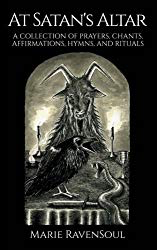
At Satan’s Altar: A Collection of Prayers, Chants, Affirmations, Hymns, and Rituals, by Marie RavenSoul
In Satan’s Honour Press, 9781775262404, 191 pp., 2018
RavenSoul’s first published title, At Satan’s Altar: A Collection of Prayers, Chants, Affirmations, Hymns, and Rituals, efficiently covers a variety of practices to honour Satan.
Divided into prayers, chants, hymns, affirmations, spiritual practices, and rituals, the text neatly provides an overview of RavenSoul’s Satanic practice, while also allowing personalization by readers for their own practices.
The text is organized to feature what many would consider introductory information in the last section, including recommendations for setting up an altar, appropriate offerings, and dedications. Stylishly designed, matte finished, evocatively illustrated, and published by RavenSoul’s own In Satan’s Honour Press, At Satan’s Altar, is a well-considered work, making it a desirable object in itself. The illustrations within, all black and white, provided by two artists Amanda MacNeil and Letitia Pfinder, vary in quality but fit the tone of the text, providing additional interest and aesthetic appeal to the work.
At Satan’s Altar was delivered to me on the same day that I saw, at my local suburban supermarket, a worker with a large black Leviathan Cross tattooed on their neck and chest, a sign which did not escape me. The common contemporary understanding of Satan as a secular figure, representing knowledge and independence, as seen in the Satanic Temple or LaVeyan Satanism, is not examined by RavenSoul or even referred too. The understanding of her individual Satanic practice as inherently religious is the only context provided. RavenSoul has a specific understanding of Satan, and as such this text may not appeal to all Satanists. While the author does encourage using the book as a springboard for the reader’s personal workings with Satan, the expressions and inferences used in the prayers and dedications describe particular aspects that may not resonate with all who honour Satan. RavenSoul clearly has a long-standing and deep relationship with her deity, and as such this text reflects a very personal understanding of who Satan is, and how he has assisted her throughout her life.
The book is divided up into sections, and cover various devotional texts, the largest being “Prayers to Satan.” The devotions are well written and express an understanding of Satan as compassionate and encouraging. The hymns are suitably repetitive yet evocative, and allow the reader to provide their own melody. At the conclusion of the book, is an in-depth nine-day devotion and one of the few rituals provided. Simple in practice and materials, the profundity of personal commitment involved transcends its modest initial impression. This unassuming nature, of words invested with emotion and intent, and offerings from the body or easily found objects, permeate the text, underlining the belief that revering your deity is about the individual, far more than it is about trappings and accessories.
As an introductory text, At Satan’s Altar is lacking in some areas. The discussion of altar creation and offerings appears near the end of the book, and only there is it mentioned that, no matter the intent of the supplicant, Satan may not be interested in accepting them as a follower1. The interchanging of terms that RavenSoul uses throughout the text, including Satan, Lucifer, Pan, Melek Ta’us, Shaitan, Cernunnos, and Iblis, amongst others, is frankly confusing, and comes with no explanation, which are presumably different aspects of the same deity. The recurrent mention of Satan as the enemy of Abraham or the Christian God, seems reactionary and old fashioned in witchcraft today, and the prayer “Testimony of the Satanic Warrior,” featuring the line “[w]e desecrate the virgin whore,”2 seems out of sync with the modern world. Describing Satan as a loving God who wishes his chosen to be strong, intelligent people conforms to current Satanic thought, but the passage “Satan dislikes the mundane, and hates time wasted on fleeting things,”3 seems to disagree with the notion of Satan as the antithesis of the Christian understanding of God. This reactionary view of Satan can be jarring.
At Satan’s Altar: A Collection of Prayers, Chants, Affirmations, Hymns, and Rituals, while it has various aspects that, if addressed, would strengthen the overall work, is an excellent addition to the library of any follower or potential follower of Satan. Both aesthetically pleasing and rich in information, the section on spiritual practices is particularly of interest. As a deeply personal work, discussing obliquely the individual relationship RavenSoul has with Satan, the ability to adapt and be selective with what the reader takes from the text is integral to its use as a workbook. Texts examining Satan as a religious deity are few and far between, often only examining the mind of the author rather than their understanding of the practical aspects of worship. As such, this book stands out for its content as much as its quality.









